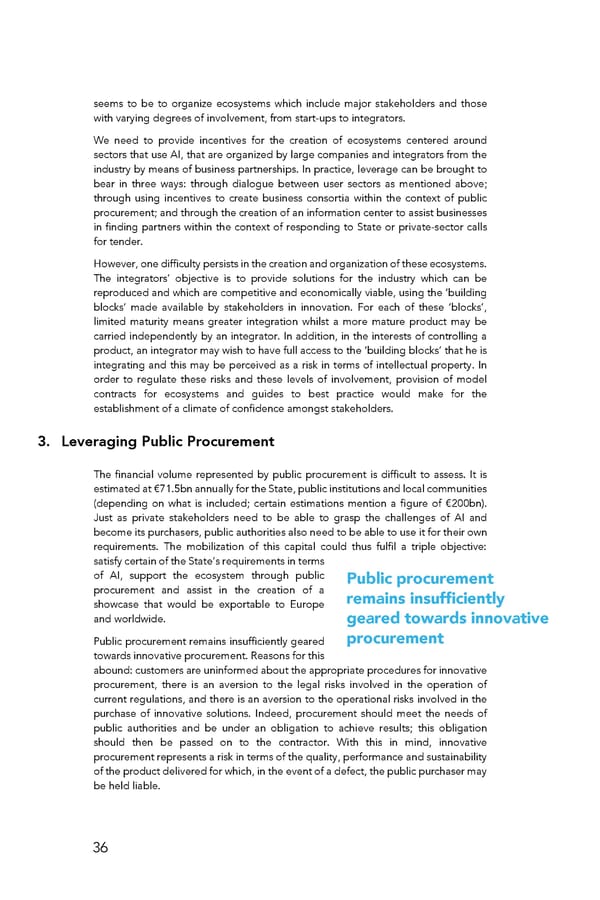seems to be to organize ecosystems which include major stakeholders and those with varying degrees of involvement, from start-ups to integrators. We need to provide incentives for the creation of ecosystems centered around sectors that use AI, that are organized by large companies and integrators from the industry by means of business partnerships. In practice, leverage can be brought to bear in three ways: through dialogue between user sectors as mentioned above; through using incentives to create business consortia within the context of public procurement; and through the creation of an information center to assist businesses in finding partners within the context of responding to State or private-sector calls for tender. However, one difficulty persists in the creation and organization of these ecosystems. The integrators’ objective is to provide solutions for the industry which can be reproduced and which are competitive and economically viable, using the ‘building blocks’ made available by stakeholders in innovation. For each of these ‘blocks’, limited maturity means greater integration whilst a more mature product may be carried independently by an integrator. In addition, in the interests of controlling a product, an integrator may wish to have full access to the ‘building blocks’ that he is integrating and this may be perceived as a risk in terms of intellectual property. In order to regulate these risks and these levels of involvement, provision of model contracts for ecosystems and guides to best practice would make for the establishment of a climate of confidence amongst stakeholders. 3. Leveraging Public Procurement The financial volume represented by public procurement is difficult to assess. It is estimated at €71.5bn annually for the State, public institutions and local communities (depending on what is included; certain estimations mention a figure of €200bn). Just as private stakeholders need to be able to grasp the challenges of AI and become its purchasers, public authorities also need to be able to use it for their own requirements. The mobilization of this capital could thus fulfil a triple objective: satisfy certain of the State’s requirements in terms of AI, support the ecosystem through public Public procurement procurement and assist in the creation of a remains insufficiently showcase that would be exportable to Europe and worldwide. geared towards innovative Public procurement remains insufficiently geared procurement towards innovative procurement. Reasons for this abound: customers are uninformed about the appropriate procedures for innovative procurement, there is an aversion to the legal risks involved in the operation of current regulations, and there is an aversion to the operational risks involved in the purchase of innovative solutions. Indeed, procurement should meet the needs of public authorities and be under an obligation to achieve results; this obligation should then be passed on to the contractor. With this in mind, innovative procurement represents a risk in terms of the quality, performance and sustainability of the product delivered for which, in the event of a defect, the public purchaser may be held liable. 36
 For a Meaningful AI - Report Page 36 Page 38
For a Meaningful AI - Report Page 36 Page 38